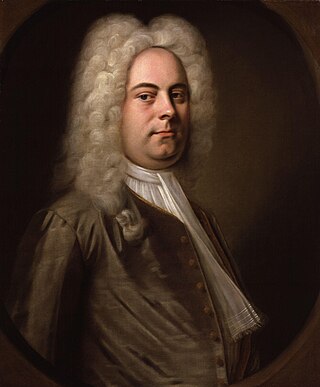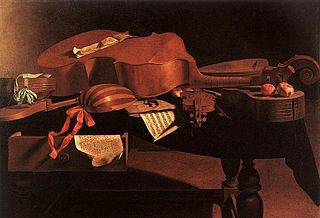
George FridericHandel was a German-British Baroque composer well known for his operas, oratorios, anthems, concerti grossi, and organ concertos. Handel received his training in Halle and worked as a composer in Hamburg and Italy before settling in London in 1712, where he spent the bulk of his career and became a naturalised British subject in 1727. He was strongly influenced both by the middle-German polyphonic choral tradition and by composers of the Italian Baroque. In turn, Handel's music forms one of the peaks of the "high baroque" style, bringing Italian opera to its highest development, creating the genres of English oratorio and organ concerto, and introducing a new style into English church music. He is consistently recognized as one of the greatest composers of his age.
The trio sonata is a genre, typically consisting of several movements, with two melody instruments and basso continuo. Originating in the early 17th century, the trio sonata was a favorite chamber ensemble combination in the Baroque era.

Trevor David Pinnock is a British harpsichordist and conductor.
The year 1730 in music involved some significant events.
The year 1726 in music involved some significant events.
The year 1711 in music involved some significant events.
William Charles Smith was an English musicologist who specialized in musical bibliographies. His particular area of interest was 17th and 18th century musical figures that were active in England. Considered an authority on the life and works of George Frideric Handel, he notably published several books on the famous composer. Smith also had a large private collection of Handel works, some of them original manuscripts. He was also interested in chronicling the work of English music engravers and publishers of the period.

L'estro armonico, Op. 3, is a set of 12 concertos for string instruments by Italian composer Antonio Vivaldi, first published in Amsterdam in 1711. Vivaldi's Twelve Trio Sonatas, Op. 1, and Twelve Violin Sonatas, Op. 2, only contained sonatas, thus L'estro armonico was his first collection of concertos appearing in print. It was also the first time he chose a foreign publisher, Estienne Roger, instead of an Italian. Each concerto was printed in eight parts: four violins, two violas, cello and continuo. The continuo part was printed as a figured bass for violone and harpsichord.
William Babell was an English musician, composer and prolific arranger of vocal music for harpsichord.
Francesco Barsanti (1690–1775) was an Italian flautist, oboist and composer. He was born in 1690 in the Tuscan city of Lucca, but spent most of his life in London and Edinburgh.

Between 1858 and 1902, the Händel-Gesellschaft produced a collected 105-volume edition of the works of George Frideric Handel. Even though the collection was initiated by the society, many of the volumes were published by Friedrich Chrysander working alone. The wording on the title page of the volumes is "Georg Friedrich Händel's Werke. Ausgabe der Deutschen Händelgesellschaft" which translates as "Georg Friedrich Handel's works. Edition of the German Handel Society". Chrysander's work has been criticised, however the scale of his achievement is also praised. The collection's abbreviation of "HG" can be used to identify individual works by Handel; for example Handel's Messiah can be referred to as "HG xlv". For practical use, the HG system has been superseded by the HWV numbering system. The 105 volumes do not contain the complete works of Handel—with at least 250 of his works unpublished in the collection.

Robert Birchall was an English music seller, publisher, and instrument dealer.

Johann Christian Schickhardt was a German composer and woodwind player.

Baroque music refers to the period or dominant style of Western classical music composed from about 1600 to 1750. The Baroque style followed the Renaissance period, and was followed in turn by the Classical period after a short transition. The Baroque period is divided into three major phases: early, middle, and late. Overlapping in time, they are conventionally dated from 1580 to 1650, from 1630 to 1700, and from 1680 to 1750. Baroque music forms a major portion of the "classical music" canon, and is widely studied, performed, and listened to. The term "baroque" comes from the Portuguese word barroco, meaning "misshapen pearl". The works of George Frideric Handel, Antonio Vivaldi and Johann Sebastian Bach are considered the pinnacle of the Baroque period. Other key composers of the Baroque era include Claudio Monteverdi, Domenico Scarlatti, Alessandro Scarlatti, Alessandro Stradella, Tomaso Albinoni, Johann Pachelbel, Henry Purcell, Georg Philipp Telemann, Jean-Baptiste Lully, Jean-Philippe Rameau, Marc-Antoine Charpentier, Arcangelo Corelli, François Couperin, Johann Hermann Schein, Heinrich Schütz, Samuel Scheidt, Dieterich Buxtehude, and others.

The Handel organ concertos, Op. 4, HWV 289–294, are six organ concertos for chamber organ and orchestra composed by George Frideric Handel in London between 1735 and 1736 and published in 1738 by the printing company of John Walsh. Written as interludes in performances of oratorios in Covent Garden, they were the first works of their kind for this combination of instruments and served as a model for later composers.
The Sonata in D minor was composed, circa 1709–15, by George Frideric Handel for recorder and basso continuo. The work is also referred to as Opus 1 No. 9a. Another catalogue of Handel's music refers to the work as HHA iv/18,19,45.

Solos for a German Flute a Hoboy or Violin with a Thorough Bass for the Harpsichord or Bass Violin Compos'd by Mr. Handel was published by John Walsh in 1732. It contains a set of twelve sonatas, for various instruments, composed by George Frideric Handel. The 63 page publication includes the sonatas that are generally known as Handel's Opus 1.

The Twelve Grand Concertos, Op. 6, HWV 319–330, by George Frideric Handel are concerti grossi for a concertino trio of two violins and cello and a ripieno four-part string orchestra with harpsichord continuo. First published by subscription in London by John Walsh in 1739, they became in a second edition two years later Handel's Opus 6. Taking the older concerto da chiesa and concerto da camera of Arcangelo Corelli as models, rather than the later three-movement Venetian concerto of Antonio Vivaldi favoured by Johann Sebastian Bach, they were written to be played during performances of Handel's oratorios and odes. Despite the conventional model, Handel incorporated in the movements the full range of his compositional styles, including trio sonatas, operatic arias, French overtures, Italian sinfonias, airs, fugues, themes and variations and a variety of dances. The concertos were largely composed of new material: they are amongst the finest examples in the genre of baroque concerto grosso.
The Musette, or rather chaconne, in this Concerto, was always in favour with the composer himself, as well as the public; for I well remember that HANDEL frequently introduced it between the parts of his Oratorios, both before and after publication. Indeed no instrumental composition that I have ever heard during the long favour of this, seemed to me more grateful and pleasing, particularly, in subject.

The Division Flute is a collection of variations over ground basses and their melodies. The Division Flute was first published in 1706/1708 by John Walsh, senior and is based on The Division Violin by John Playford. Most of the grounds are anonymous folk songs taken from different styles like the French chaconne or the Italian Ostinato.











